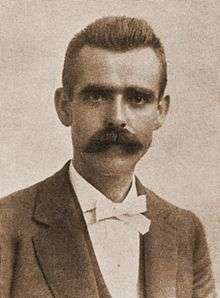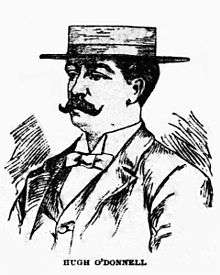Hugh O'Donnell (labor leader)

Hugh "Hughey" O'Donnell (c. 1869-????) was an American steel mill worker and labor leader. He is best remembered as the chairman of the Homestead Strike Advisory Committee during the Homestead Steel Strike of July 1892.
Biography
Early years
Hugh O'Donnell came work at the Carnegie Steel Company works at Homestead, Pennsylvania in 1886, at the age of 17.[1] After 6 months in the sheet metal mill he moved to the Homestead works' mill which produced 119-inch steel plate, in which he worked as a heater.[1]
O'Donnell joined the Amalgamated Association of Iron and Steel Workers and was a member of that organization's Lodge No. 125.[1]
At the time of the Homestead labor dispute, O'Donnell was employed as a mill worker, and not as a professional trade union functionary.
Leadership of the Homestead strike

O'Donnell was named chairman of the Advisory Committee, the workers' organization in charge of coordination of the strike.[2] In this capacity he had cautioned against violence and trespassing upon company property in an attempt to keep the company from availing itself of judicial injunction or the seizing of the moral high ground.[3]
The Advisory Committee established its headquarters on the third floor of the Bost Building, located at the corner of Eighth Avenue and Heisel Street in Homestead.[4]
Events of July 6

At 10:30 pm on July 5, 1892, some 300 employees of the Pinkerton National Detective Agency arrived by rail at Bellevue, about five miles south of Pittsburgh along the Ohio River.[5] These were put aboard two specially equipped barges, laden with 300 pistols and 250 Winchester rifles, and pulled by tugboat up the river to Homestead.[5] Strike leaders, who assigned lookouts to keep a watch along rivers and rail routes, were apprised by telegram at 2:30 am of July 6 that barges had departed for the steel works and ten minutes later a warning alarm was sounded, echoed by whistles throughout the town.[2]
Chaos ensued and O'Donnell immediately lost control of the defense of the steelworks, which was spontaneously led by residents of Homestead.[2] Armed strikers assembled at the steelworks and shots were fired at the tugboat pulling the barges, one of which shattered a window in the pilothouse.[2] Some of those coming forward in impromptu leadership roles included Margaret Finch, the feisty widow of a steelworker who operated the Rolling Mill House saloon, English immigrant laborer William Foy, and open-hearth skilled worker Anthony Soulier.[6]
As dawn began to break at 4:00 am, a crowd had gathered along the riverbank next to a barbed wire fence which ran from the plant to the river, which had been erected by the company some weeks earlier.[3] The barges were pushed ashore at 4:30, to a cascade of angry shouts and a hail of stones, many of which were thrown by the hundreds of wives of strikers who had assembled.[7]
Gangplanks were lowered and William Foy and Capt. Frederick H. Heinde, commander of the Pinkerton landing operation, tensely faced off amidst mutual threats.[8] A fracas erupted, with clubs wielded and shots were fired, with both Foy and Heinde hit by bullets.[8] The Pinkertons began firing their rifles repeatedly into the crowd, with armed strikers answering in kind, and for the next ten minutes a pitched gun battle was waged; several strikers and two Pinkertons were mortally wounded, with dozens of others injured, including Hugh O'Donnell, who was grazed by a bullet to his thumb.[9]
The Pinkertons remained trapped aboard the barges, while O'Donnell and his associates of the Advisory Committee attempted to restore order to the tense and bloody situation, removing wives and wounded strikers from the scene and O'Donnell personally attempting, to the best of his ability, to calm and organize the crowd.[4]
After the battle
On July 12, 1892, O'Donnell chaired a mass meeting in Homestead which voted unanimously to support the introduction into town of the National Guard, which had been called out by Pennsylvania Governor Robert E. Pattison.[10] The meeting was addressed by Homestead burgess (mayor) John McLuckie, who railed against the Pinkertons as members of a "dirty, filthy, stinking" organization while encouraging reception of the militia "with open arms," since "they are not dangerous so long as the dignity of the state is not insulted."[10]
See also
Footnotes
- 1 2 3 O'Donnell testimony to the House Judiciary Committee, Investigation of the Employment of Pinkerton Detectives in Connection with the Labor Troubles at Homestead, PA. Washington, DC: US Government Printing Office, 1892; pp. 86-87.
- 1 2 3 4 Paul Krause, The Battle for Homestead, 1880-1892: Politics, Culture, and Steel. Pittsburgh: University of Pittsburgh Press, 1992; pg. 16.
- 1 2 Krause, The Battle for Homestead, pg. 17.
- 1 2 Krause, The Battle for Homestead, pg. 21.
- 1 2 Krause, The Battle for Homestead, pg. 15.
- ↑ Krause, The Battle for Homestead, pp. 16-17.
- ↑ Krause, The Battle for Homestead, pp. 17-18.
- 1 2 Krause, The Battle for Homestead, pg. 19.
- ↑ Krause, The Battle for Homestead, pp. 19-20.
- 1 2 "Ready for the Troops," Wilkes-Barre Evening News, July 12, 1892, pg. 1.
Further reading
- Arthur G. Burgoyne, Homestead: A Complete History of the Struggle of July, 1892, between the Carnegie Steel Company, Limited, and the Amalgamated Association of Iron and Steel Workers. Pittsburgh: privately published, 1893.
- David P. Demarest, Jr. (ed.), "The River Ran Red": Homestead, 1892. Pittsburgh: University of Pittsburgh Press, 1992.
- Paul Krause, The Battle for Homestead, 1880-1892: Politics, Culture, and Steel. Pittsburgh: University of Pittsburgh Press, 1992.
- House Judiciary Committee, Investigation of the Employment of Pinkerton Detectives in Connection with the Labor Troubles at Homestead, PA. Washington, DC: US Government Printing Office, 1892. —O'Donnell's testimony on pp. 86-97.
- William C. Oates, George Ticknor Curtis, and Terence V. Powderly, "The Homestead Strike," North American Review, vol. 155, whole no. 430 (Sept. 1892), pp. 355-375.
External links
- Rivers of Steel National Heritage Area Online Collections Database, www.riversofsteel.pastperfectonline.com/